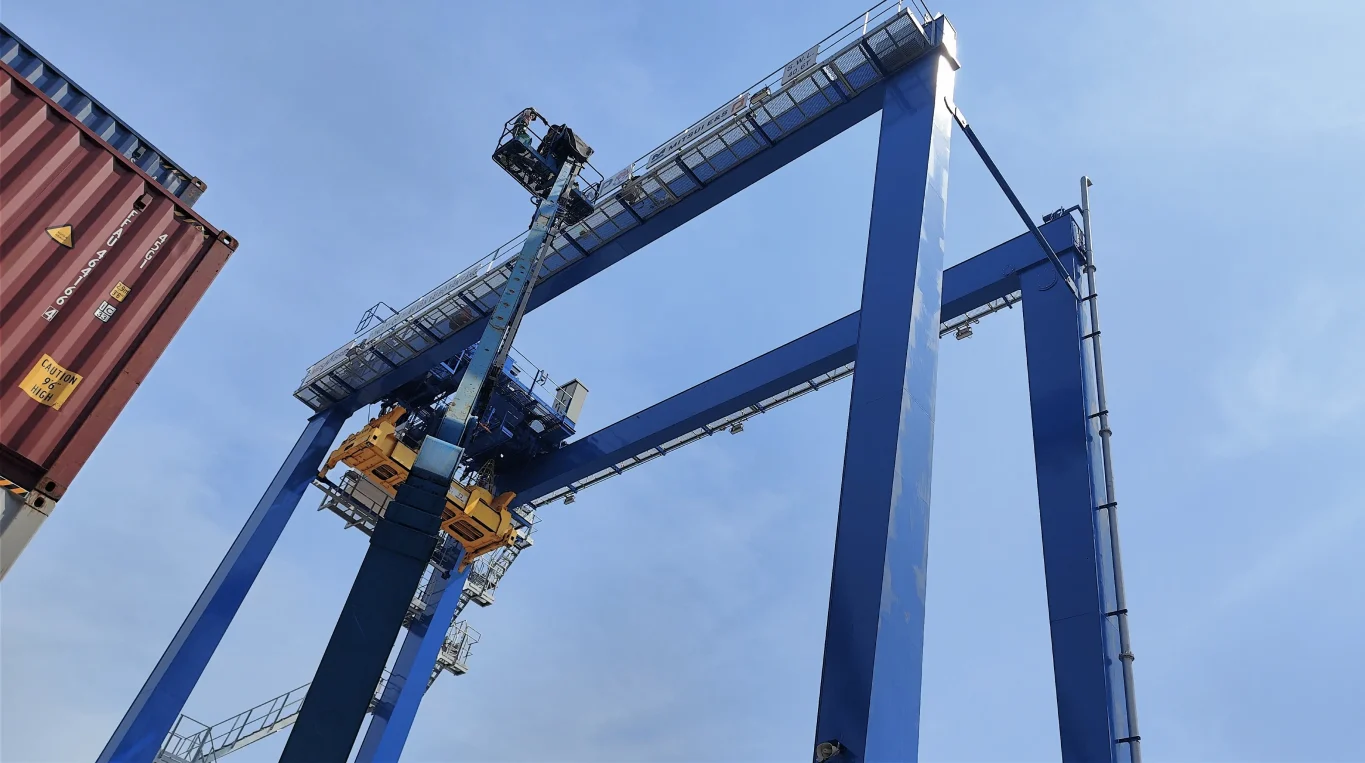The giant STS (Ship-to-Shore) and RTG (Rubber-Tired Gantry) cranes are symbols of the power and efficiency of a modern seaport. However, this magnificent exterior is protected by an often-overlooked element: the paint coat. For port equipment, paint is not just an “aesthetic coat” but also the most critical “protective shield,” determining the lifespan, safety, and operational efficiency of an entire multi-million dollar system.
Enhancing Aesthetics and Protecting the Structure of Port Equipment

Port equipment must always operate in harsh environments, facing rain, sun, extreme weather, and especially highly corrosive atmospheres. This is even more pronounced in tropical countries. If technical maintenance is not performed well and systematically, the equipment can rapidly deteriorate, becoming unsafe and unsightly.
Constant Corrosion: The air at a port always contains a high concentration of salt vapor, creating a powerful electrolytic solution that accelerates the oxidation process (rusting) many times faster than in a normal environment. Harsh UV radiation from the sun causes the color topcoat to age and chalk, while near-constant high humidity continuously seeps into the smallest crevices, putting the equipment’s steel structure under severe threat.
Mechanical Impact: The continuous process of moving and lifting containers creates vibrations and microscopic material deformations. These impacts cause micro-cracks on the paint surface, creating “gateways” for corrosive agents to penetrate.
The Critical Weak Point – Welds: Welded joints are the “Achilles’ heel” of any steel structure. The welding process alters the steel’s microstructure in the Heat-Affected Zone (HAZ), making it more susceptible to corrosion. If the paint coat in this area is damaged, corrosion will occur extremely quickly, eating deep into the structure and spreading beneath the paint, causing blistering.
The consequences of a weakened protective coating are not just a severe loss of aesthetics. When the steel structure corrodes, it reduces the equipment’s load-bearing capacity. Phenomena like pitting corrosion can create deep holes, severely weakening the structure at a single point and posing a latent risk of fracture, collapse, or severe structural deformation if suddenly subjected to excessive force.
Inspecting the Paint Coat on Port Equipment and Intervening Promptly

Over time, the paint coat will inevitably degrade. Regular inspection and maintenance are vital to extending the equipment’s lifespan. Below are common approaches:
1. Visual Inspection
– Lowest cost: Does not require expensive equipment.
– Fast and flexible: Can be performed regularly by the on-site technical team.
– Detects obvious defects: Blistering, peeling, surface rust, paint chalking.
– Low accuracy: Highly dependent on the inspector’s experience.
– Misses micro-defects: Cannot detect small cracks, pinholes, or a reduction in paint thickness.
2. Inspection with Specialized Equipment
– High accuracy: Provides quantitative data (thickness, adhesion).
– Detects hidden defects: A Holiday Detector can find invisible flaws.
– Basis for planning: Data helps determine when a full repaint is necessary.
– High cost: Requires investment in equipment and specialized training for personnel.
– Time-consuming: A thorough inspection process takes longer.
3. Early Intervention, Spot Repair
– Cost-effective: Only damaged areas are treated, avoiding a full repaint.
– Quick: Reduces equipment downtime.
– Difficult to blend: The new and old paint surfaces may not match in color and properties.
– High risk if surface preparation is poor: If rust is not completely removed, the repaired area will quickly fail again.
The Perspective of Tan Cang Technical Services
For the port system in Vietnam, with its relatively harsh operating environment—especially for ports located at river mouths or directly on the coast that face not only sun, wind, and humidity but also much higher salt concentrations—paint inspection and maintenance need to be performed more frequently. To balance cost and risk, the approach proposed by DVKT is to conduct frequent visual inspections combined with localized spot repairs and comprehensive inspections every 1-2 years.
- The port must ensure that all personnel understand that port equipment, especially STS cranes, RTG cranes, and quayside cranes, are the organization’s “strategic assets.” This requires the coordinated effort of all parties: crane operators, on-site supervisors, maintenance teams, and cargo handlers, which increases the chances of detecting damage not only to the paint but also to the equipment itself.
- Organize technical teams to perform weekly/monthly visual inspections to detect early signs of paint degradation.
- Intervene quickly: As soon as a small or potential defect is found, perform spot repairs immediately to prevent the spread of corrosion. Temporarily mark and photograph the defect’s location before repainting for future re-evaluation.
- Schedule inspections with specialized equipment every 1-2 years for critical areas (crane legs, main girders, major welds) to assess the overall condition and decide on a full repaint plan if necessary (primer, intermediate coat, and topcoat for port equipment).
Key Lessons from DVKT for Repainting Port Equipment
Repainting port equipment is not as simple as applying a new coat of paint. To achieve the goal of ensuring structural safety, it is a relatively complex task that includes:
Surface Preparation: This is the most critical step, accounting for 70% of the paint job’s success, much like painting a house. The surface must be completely cleaned of grease, dirt, rust, and old paint.
Choosing the Right Coating System: A specialized industrial coating system for marine environments (corrosivity category C5-M) must be used. A standard system typically includes 3 layers:
- Primer: An Epoxy Zinc-Rich Primer for electrochemical corrosion protection.
- Intermediate Coat: A High Build Epoxy to increase impact resistance and create a barrier against moisture.
- Topcoat: A Polyurethane (PU) coat for UV resistance, color retention, and a glossy finish.
Apply on Sunny Days: Never paint when it is raining, when humidity is >85%, or when the steel surface temperature is less than 3°C above the dew point (to avoid condensation on the surface, which affects paint quality).
Control Dry Film Thickness (DFT): Each coat must achieve the thickness specified by the manufacturer. Paint that is too thin will not provide adequate protection, while paint that is too thick can become brittle, leading to cracking and peeling.
Some Quality Assessment Factors
To ensure maintenance painting meets quality standards, acceptance must be based on quantitative criteria, not just visual appearance.
Surface Cleanliness: A visual comparison of the cleaned surface with the ISO 8501-1 standard photo set can be performed. The minimum requirement is grade Sa 2.5 (Near-white blast cleaning, where remaining contaminants are visible on a maximum of 5% of the surface area).

Dry Film Thickness (DFT) Inspection: Use a specialized coating thickness gauge. Measurements should comply with the SSPC-PA2 standard, which specifies the method for taking readings, the number of measurement points per area, and the allowable tolerance.
Adhesion Test: The common method is the Cross-Hatch Test (according to ASTM D3359). A specialized knife is used to cut a grid of parallel and perpendicular lines on the paint surface. A special adhesive tape is then applied over the grid and pulled off. The adhesion quality is assessed based on the amount of paint removed by the tape.

Coating Defect Inspection (Holiday Test): Use a Holiday Detector to check for defects, pinholes, and micro-cracks invisible to the naked eye. This is especially important for the anti-corrosion primer coat.
In conclusion, investing in the painting and maintenance of port equipment is not an expense but a strategic investment in safety, sustainability, and efficiency. A high-quality paint system, applied and maintained according to proper technical procedures, will help port operators save millions of dollars in major repair costs, maintain their brand image, and ensure their assets operate stably and retain their value for many years.

